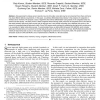IJAHUC
2010
13 years 7 months ago
2010
Abstract: The unique characteristics of space networks lead to different research approaches from those in terrestrial networks. In this paper, a routing framework called Space Gat...
IPPS
2010
IEEE
13 years 10 months ago
2010
IEEE
Innovative scientific applications and emerging dense data sources are creating a data deluge for highend computing systems. Processing such large input data typically involves cop...
TMC
2008
14 years 19 days ago
2008
Data generated in wireless sensor networks may not all be alike: some data may be more important than others and hence may have different delivery requirements. In this paper, we a...
IJDSN
2006
14 years 22 days ago
2006
Mobile ad hoc networks are self-organizing networks that provide rapid network connectivity in infrastructureless environments. Most routing protocols designed for MANETs assume c...
ATAL
2006
Springer
14 years 4 months ago
2006
Springer
This paper studies scalable data delivery algorithms in mobile ad hoc sensor networks with node and link failures. Many algorithms have been developed for data delivery and fusion...
PERCOM
2010
ACM
14 years 4 months ago
2010
ACM
—Some current and future pervasive data driven applications must operate in ”extreme” environments where endto-end connectivity cannot be guaranteed at all times. In fact, it...
WORDS
2002
IEEE
14 years 5 months ago
2002
IEEE
The majority of today’s Internet-based services are generally not concerned about the level of Quality of Service (QoS) presented to their users. For many such services, however...
IPSN
2003
Springer
14 years 6 months ago
2003
Springer
Although data forwarding algorithms and protocols have been among the first set of issues explored in sensor networking, how to reliably deliver sensing data through a vast field...
NOSSDAV
2004
Springer
14 years 6 months ago
2004
Springer
We present a low-overhead media streaming system, called SRMS (Scalable Resilient Media Streaming) that can be used to scalably deliver streaming data to a large group of receiver...
MOBIHOC
2004
ACM
14 years 6 months ago
2004
ACM
Mobile Ad Hoc Networks (MANETs) provide rapidly deployable and self-configuring network capacity required in many critical applications, e.g., battlefields, disaster relief and ...


